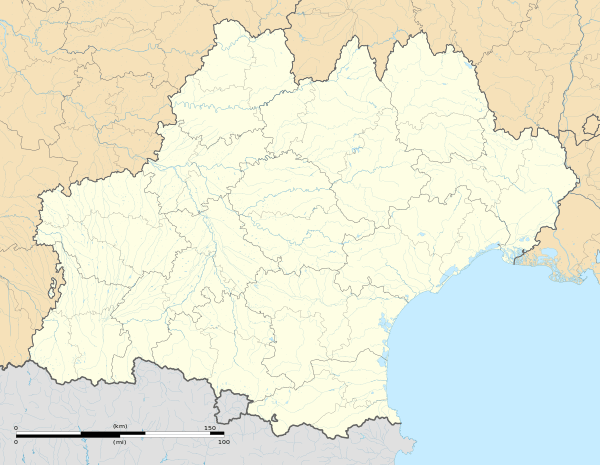Appy, Ariège
Appy is a commune in the Ariège department in the Occitanie region of southwestern France.
Appy | |
|---|---|
 The "Etang d'Appy" in Summer | |
Location of Appy 
| |
 Appy  Appy | |
| Coordinates: 42°47′29″N 1°44′02″E | |
| Country | France |
| Region | Occitanie |
| Department | Ariège |
| Arrondissement | Foix |
| Canton | Haute-Ariège |
| Intercommunality | Haute-Ariège |
| Government | |
| • Mayor (2014-2020) | Yves Huez |
| Area 1 | 6.1 km2 (2.4 sq mi) |
| Population (2017-01-01)[1] | 25 |
| • Density | 4.1/km2 (11/sq mi) |
| Time zone | UTC+01:00 (CET) |
| • Summer (DST) | UTC+02:00 (CEST) |
| INSEE/Postal code | 09012 /09250 |
| Elevation | 744–2,168 m (2,441–7,113 ft) (avg. 930 m or 3,050 ft) |
| 1 French Land Register data, which excludes lakes, ponds, glaciers > 1 km2 (0.386 sq mi or 247 acres) and river estuaries. | |
The inhabitants of the commune are known as Pynarols or Pynaroles[2]
Geography
Appy is located some 15 km south-east of Tarascon-sur-Ariège and 12 km north-west of Ax-les-Thermes. Access is by the D20 road from Axiat in the east passing through the village and continuing to Caychax in the west. Appy is a remote mountainous commune, heavily forested in the south and west, with the rest alpine terrain.[3]
In the north of the commune is the Etang d'Appy from which flows the Ruisseau de Lac d'Appy towards the south-west to join the Ruisseau de Caychax which joins the Ariège at Albiès. The eastern boundary of the commune is formed by the Ruisseau de Girabel which flows south joining with other streams to join the Ariege at Urs. The Ruisseau de Camelong rises north of the village and flows south-east to join the Ruisseau de la Cassagne.[3]
Neighbouring communes and villages[3]
Administration
List of Successive Mayors[4]
| From | To | Name | Party | Position |
|---|---|---|---|---|
| 2001 | Current | Yves Huez | DVG |
(Not all data is known)
Demography
The village became almost uninhabited, so much so that there was a period of 64 years without a marriage: there was a marriage in 1946 then one in 2010 which was the subject of an article in La Dépêche du Midi.[5]
| Year | Pop. | ±% |
|---|---|---|
| 2006 | 21 | — |
| 2007 | 23 | +9.5% |
| 2008 | 24 | +4.3% |
| 2009 | 27 | +12.5% |
| 2010 | 28 | +3.7% |
| 2011 | 29 | +3.6% |
| 2012 | 31 | +6.9% |
| 2013 | 32 | +3.2% |
| 2014 | 29 | −9.4% |
| 2015 | 26 | −10.3% |
| 2016 | 24 | −7.7% |


See also
External links
- Appy on the National Geographic Institute website (in French)
- Appy on Lion1906
- Appy on Géoportail, National Geographic Institute (IGN) website (in French)
- Appi on the 1750 Cassini Map
Notes and references
Notes
References
- "Populations légales 2017". INSEE. Retrieved 6 January 2020.
- Inhabitants of Ariège (in French)
- Google Maps
- List of Mayors of France
- Appy: finally a marriage!, La Dépêche du Midi, Jean Martinet, 28 June 2010 (in French)
| Wikimedia Commons has media related to Appy. |